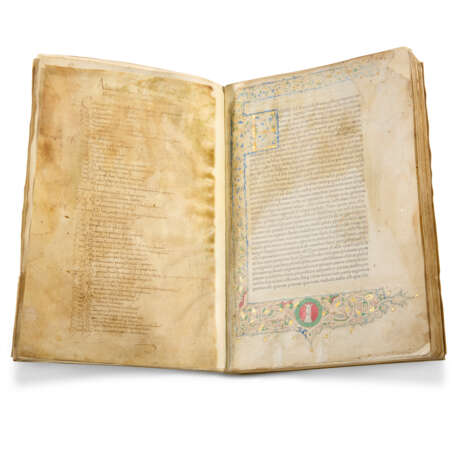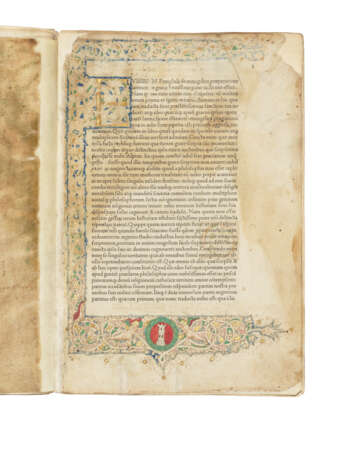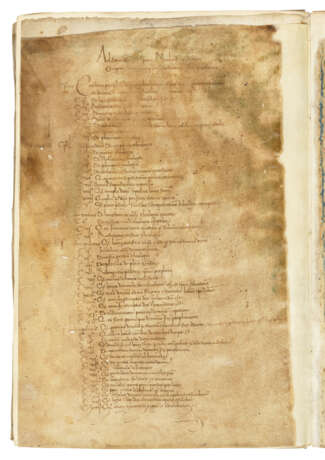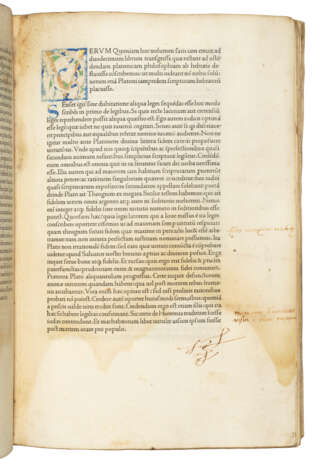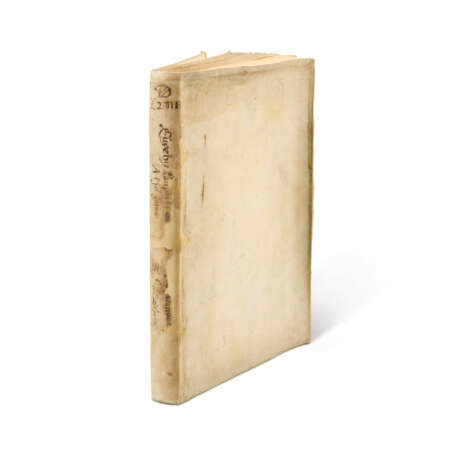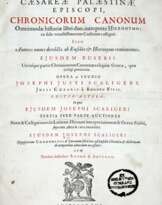ID 1249781
Lot 118 | EUSEBIUS CAESARIENSIS (c.260-340)
Estimate value
£ 20 000 – 30 000
De evangelica preparatione. Translated by Georgius Trapezuntius. Venice: Nicolaus Jenson, 1470.
Rare first publication from the press of influential printer Nicolaus Jenson, showcasing for the first time ‘the most perfect roman typeface’ (William Morris). We are unable to trace any copy at auction since 1964. Jenson studied the design of moveable type in Mainz from 1458-1461 and opened his printing shop in Venice in 1470, issuing in that year five works of which the present title is believed to be the first. The model for William Morris’s ‘Golden Type’ used at the Kelmscott Press, Jenson’s typeface was ‘the first to be designed in accordance with typographical criteria, free of the conventions of written models. Jenson sought to create ideal individual letters, which by means of subtleties of fit and alignment would combine harmoniously on a page’ (Berry & Poole, Annals of Printing).
‘This roman font is one of the greatest typefaces ever designed. Every Western type designer […] has been influenced by Jenson’ (Goldberg).
The text constitutes the first edition of an introduction to Christianity for pagans by the Father of Church History. It is particularly remarkable for its preservation of non-Christian works which would otherwise have been lost, including a Greek account of the Buddhist three marks of existence, some fragments of a work by Sanchuniathon the Phoenician, and excerpts from the lost works of the Platonists Atticus, Numenius of Apamea, and Porphyry. H 6699* = 6701; GW 9440; Goff E-118; BMC V 167; BSB-Ink E-115; Bod-inc E-047; ISTC ie00118000.
Median folio (334 x 231mm). 142 leaves. 11 contemporary illuminated white-vine initials coloured in blue, pink and green, opening initial with extended 3-sided border incorporating armorial of a tower in lower margin, other initials in blue throughout, early ink foliation to outer corners on verso, preserving ms. index in a humanist hand on vellum (washed, illuminated border rather worn and faded, minor marginal repairs throughout, mostly to gutter but into border on first leaf, variable dampstaining, minor wormholes in first and final few leaves restored in 1935 at the Vatican according to documents tipped onto endpaper). Later vellum (restored). Provenance: ?17th-century inscription on endpaper, partly erased, possibly from a Franciscan monastery – Doria family, counts of Montaldeo, engraved armorial bookplate of ‘Johannis Caroli de Auria ex comitibus Montis Aldei’ – by descent.
| Artist: | Eusebius Caesariensis (260 - 339) |
|---|---|
| Place of origin: | Italy, Europe |
| Auction house category: | Antiquarian books, Books and manuscripts, Printed books |
| Artist: | Eusebius Caesariensis (260 - 339) |
|---|---|
| Place of origin: | Italy, Europe |
| Auction house category: | Antiquarian books, Books and manuscripts, Printed books |
| Address of auction |
CHRISTIE'S 8 King Street, St. James's SW1Y 6QT London United Kingdom | |
|---|---|---|
| Preview |
| |
| Phone | +44 (0)20 7839 9060 | |
| Buyer Premium | see on Website | |
| Conditions of purchase | Conditions of purchase |
